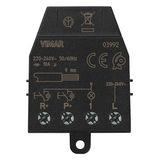Vimar Relays






vimar relays assortment and voltage options
For lighting, small motors, and mixed auxiliaries, the vimar relays line covers 1–4 CO contacts, 6–16 A ratings, and coils at 12/24 V AC-DC and 110/230 V AC. Clear contact maps on the body, lockable test buttons, and mechanical flags make commissioning fast, while optional surge suppressors keep coil kick from upsetting nearby I/O.
vimar interface relays signal adaptation and isolation
Panel builders use vimar interface relays to bridge PLC or KNX outputs to field loads, converting low-power logic into clean, galvanically isolated contacts. Slim 6–12 mm modules with plug-in blades, LED coil indication, and clip-on diodes/RC snubbers keep gutters tidy and noise off analog lines.
vimar solid state relays silent switching and lifetime
Where cycles are high or silence matters, vimar solid state relays switch AC or DC loads without mechanical wear. Zero-cross types reduce inrush on lamps and heaters; random-fire variants suit phase control. Specify baseplate temperature, required heatsink, and dv/dt immunity when these sit near VFDs.
vimar industrial relay modules prewired banks and diagnostics
Factory-jumpered racks bundle 4–16 channels with common positives/negatives, fused outputs, and field pluggables. Opto-isolated inputs and blown-fuse LEDs speed fault finding. In controls for AHUs and pump skids, vimar industrial relay modules cut wiring time and standardize terminal numbering across floors.
vimar relay sockets bases jumpers and IDs
Din-mount and panel bases accept retaining clips, eject levers, and marker windows; jumpers common coils or contacts across a row. Screw and spring terminals cover 0.5…2.5 mm² with printed strip lengths on the side. Crews prefer vimar relay sockets that take both mechanical and electronic timers without changing the footprint.
vimar control relays timing latching and logic
Multifunction timers (on-delay, off-delay, interval, star-delta) with 0.1 s…100 h ranges, latching/impulse relays, and phase-monitor variants ride the same 17.5 mm pitch. With front selectors and clear scales, vimar control relays let you set duty/assist alternation and run-on times without a laptop.
vimar din rail relays selection and coordination
From 6 A signal duty to 16 A lighting/motor auxiliaries, vimar din rail relays list AC-1/AC-15/AC-3 data on the label for quick curve and cable checks. Use AgSnO2 contacts for lamp loads, add arc chutes where inrush is severe, and document coil suppression so EMC tests pass first time.
Technical specifications and standards that matter
Contact performance to IEC 61810/60947-5-1; timers per IEC 60669-2-3; insulation categories marked on the body. Dielectric strength typically ≥ 2.5–4 kV; creepage/clearance sized for 230/400 V AC panels (pollution degree 2). Terminals 0.5…2.5 mm² Cu; torque 0.4–0.8 Nm; strip 8–10 mm. Ambient −20…+55 °C; derate beside warm drives; allow 7.5–10 mm breathing between heat sources.
Applications and integration
- Lighting: driver enable, scene groups, stair timers; contact material chosen for capacitive inrush.
- HVAC: fan/pump interlocks, frost and filter DP alarms, VFD run/OK feedback via auxiliary contacts.
- Access and gates: beacon/traffic outputs, edge/photocell loops via opto inputs, safe power cut with shunt trip.
- BMS/KNX: logic outputs buffered into field loads; coil voltage matched to bus couplers; status back to supervisors through AUX blocks.
All units share DIN geometry with the brand’s breakers, SPDs, and enclosures, so rails and labels stay uniform.
Selection criteria for B2B buyers
- Define the load (resistive, lamp, inductive) and pick contact set, material, and AC-1/AC-15/AC-3 rating.
- Fix coil voltage and suppression (diode, RC, varistor) to protect PLC/KNX outputs and nearby analog.
- Choose socket type (screw vs spring), clip, and marker system; plan jumpers for commons.
- For high duty or silent rooms, move to SSRs and size heatsinks/ventilation.
- Publish torque, strip lengths, test buttons use, and labeling so every board lands the same result at FAT.
Advantages of working with Bankoflamps
Procurement follows your commissioning windows: job-specific pricing, near-hour quote turnaround by EAN/MPN, and live EU stock before panels are scheduled. The portal shows lead times, shipment tracking, and downloadable price lists with validity periods you can plan against. Trusted clients can use post-payment up to 30 days. We consolidate partials so relays, sockets, timers, jumpers, suppressors, and labels arrive rail-bundled by riser. Your account manager cross-checks coil voltages, contact ratings, EMC notes, spacing, and marker schemes against your drawings—keeping deliveries site-ready across France, the Baltics, Germany, Spain, Italy, Belgium, and the Netherlands.